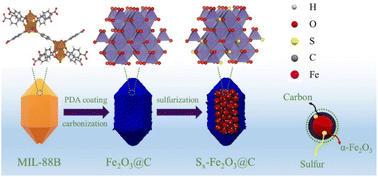Low volume expansion hierarchical porous sulfur-doped Fe2O3@C with high-rate capability for superior lithium storage†
Abstract
Ingenious morphology design and doping engineering have remarkable effects on enhancing conductivity and reducing volume expansion, which need to be improved by transition metal oxides serving as anode materials for lithium-ion batteries. Herein, S0.15–Fe2O3@C nano-spindles with a hierarchical porous structure are obtained by carbonizing MIL-88B@PDA and subsequent high-temperature S-doping. Kinetic analysis showed that S-doping increases capacitive contribution, enhances charge transfer capability and accelerates Li+ diffusion rate. Therefore, the S0.15–Fe2O3@C electrode exhibits superior lithium storage performance with a remarkable specific capacity of 1014.4 mA h g−1 at 200 mA g−1, ultrahigh rate capability of 513.1 mA h g−1 at 5.0 A g−1, and excellent cycling stability of 842.3 mA h g−1 at 1.0 A g−1 after 500 cycles. Moreover, the size of S0.15–Fe2O3@C particles barely changed after 50 cycles, indicating an extremely low volume expansion, related to the carbon shell, fine Fe2O3 nanoparticles, abundant voids inside, and improved kinetics. This strategy can be applied to other metal oxides for synthesizing anodes with high-rate capability and low volume expansion.



 Please wait while we load your content...
Please wait while we load your content...